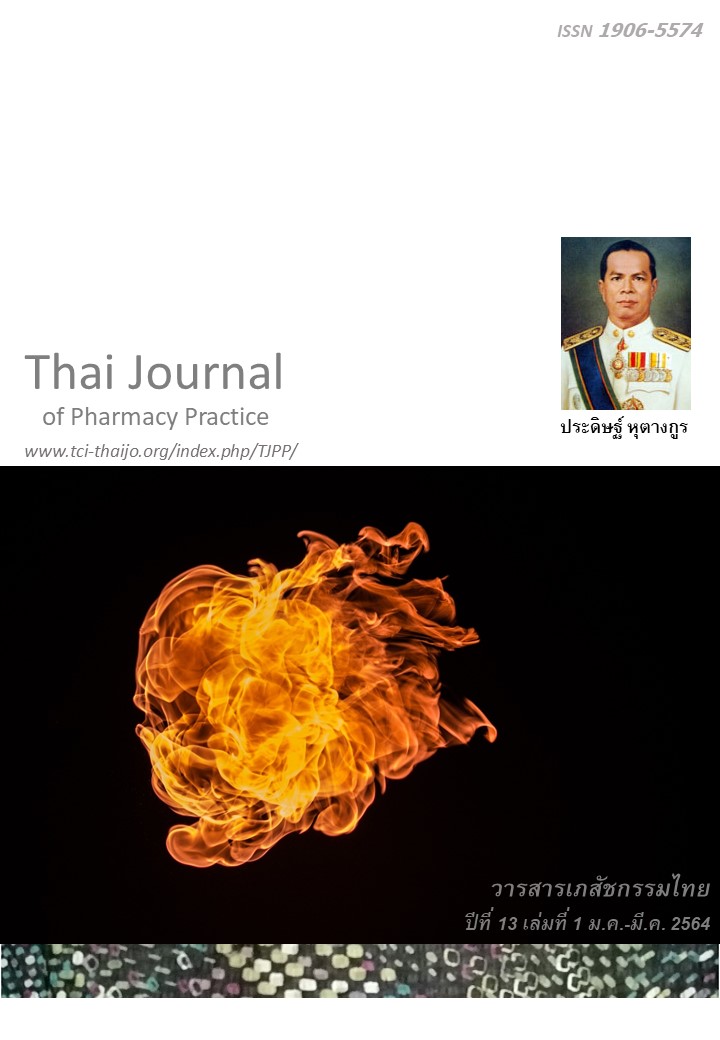ความชุกและปัจจัยที่มีความสัมพันธ์ต่อการปนเปื้อนเชื้อแบคทีเรียในผลิตภัณฑ์แหนมและปลาส้ม
Main Article Content
บทคัดย่อ
วัตถุประสงค์: เพื่อศึกษาความชุกและปัจจัยที่มีความสัมพันธ์ต่อการปนเปื้อนเชื้อแบคทีเรียในแหนมและปลาส้ม วิธีการ: เป็นการศึกษาเชิงวิเคราะห์ภาคตัดขวาง มีขอบข่ายการศึกษาการปนเปื้อนเชื้อแบคทีเรียจำนวน 3 ชนิดได้แก่ Escherichia coli, Staphylococcus aureus และ Salmonella spp. ในแหนมและปลาส้ม พื้นที่จังหวัดเชียงราย พะเยา แพร่ และน่าน ตั้งแต่กระบวนการผลิตแหนมและปลาส้มจนถึงการจำหน่าย โดยเก็บรวบรวมข้อมูลสถานที่ผลิต ประเมินตาม GMP/primary GMP ของสถานที่ผลิตและข้อมูลสถานที่จำหน่าย ประเมินความรู้หลักเกณฑ์การผลิตที่ดีและสุขลักษณะของผู้ปฏิบัติงาน ความรู้ของผู้จัดจำหน่ายประเด็นการเก็บรักษาผลิตภัณฑ์และสุขลักษณะ วิเคราะห์ข้อมูลด้วยสถิติเชิงพรรณนา และสถิติเชิงอนุมาน โดยสถิติไค-สแควร์และฟิชเชอร์เอ็กแซก ผลการวิจัย: จากผลิตภัณฑ์แหนม 105 ตัวอย่าง และปลาส้ม 22 ตัวอย่าง พบความชุกของการปนเปื้อนเชื้อในแหนมและปลาส้ม ร้อยละ 73.3 และ 86.4 ตามลำดับ สถานที่ผลิตแหนม 30 แห่งและสถานที่ผลิตปลาส้ม 6 แห่ง พบว่าสถานที่ผลิตผ่าน GMP สำหรับผลิตแหนมและ primary GMP สำหรับปลาส้ม ร้อยละ 50.0 และ 100.0 ตามลำดับ ความรู้เรื่องหลักเกณฑ์การผลิตที่ดี พบว่าผู้ปฏิบัติงาน 36 ราย มีความรู้เรื่องหลักเกณฑ์การผลิตในระดับดี และปานกลาง ร้อยละ 61.1 และ 33.3 ตามลำดับ ผู้ปฏิบัติงานมีสุขลักษณะอยู่ในระดับดี ปานกลาง ไม่ดี ร้อยละ 38.9, 38.9 และ 22.2 ตามลำดับ ในส่วนสภานที่จำหน่าย ความรู้ของผู้จำหน่าย 91 ราย ด้านการป้องกันการปนเปื้อนของอาหาร พบว่ามีความรู้ในระดับปานกลาง ร้อยละ 74.7 ปัจจัยที่สัมพันธ์ต่อการปนเปื้อนเชื้อแบคทีเรียในแหนมและปลาส้มด้านสถานที่ผลิตอย่างมีนัยสำคัญทางสถิติที่ p-value < 0.05 ได้แก่ สถานที่ผลิตที่ผ่าน GMP/Primary GMP เครื่องมือและการควบคุมกระบวนการผลิตที่ดี การบำรุงรักษาและความสะอาด สุขลักษณะและด้านความรู้ในเรื่องของหลักเกณฑ์การผลิตที่ดี (GMP) และปัจจัยสัมพันธ์ต่อการปนเปื้อนเชื้อแบคทีเรียในแหนมและปลาส้มด้านสถานที่จำหน่ายอย่างมีนัยสำคัญทางสถิติที่ p-value < 0.05 ได้แก่ ระยะเวลาจำหน่าย อุณหภูมิในการเก็บขณะจำหน่ายและไม่จำหน่าย สรุป: ผลิตภัณฑ์แหนมและปลาส้มที่มีคุณภาพและไม่มีการปนเปื้อนเชื้อแบคทีเรีย ควรมีหลักเกณฑ์การผลิตที่ดีตามมาตรฐาน GMP/primary GMP และในทุกขั้นตอน การให้ความรู้แก่ผู้ปฏิบัติงานในสถานที่ผลิต และความรู้ของผู้จัดจำหน่ายในการจำหน่ายและจัดเก็บผลิตภัณฑ์ในอุณหภูมิที่เหมาะสม
Article Details
ผลการวิจัยและความคิดเห็นที่ปรากฏในบทความถือเป็นความคิดเห็นและอยู่ในความรับผิดชอบของผู้นิพนธ์ มิใช่ความเห็นหรือความรับผิดชอบของกองบรรณาธิการ หรือคณะเภสัชศาสตร์ มหาวิทยาลัยสงขลานครินทร์ ทั้งนี้ไม่รวมความผิดพลาดอันเกิดจากการพิมพ์ บทความที่ได้รับการเผยแพร่โดยวารสารเภสัชกรรมไทยถือเป็นสิทธิ์ของวารสารฯ
เอกสารอ้างอิง
World Health Organization. Food safety fact sheet N°399 [online]. 2014 [cited Aug 1, 2009]. Available from: www.who.int/mediacentre/factsheets/fs399/ en/.
De Waal CS, Robert N. Global and local: food safety around the world [online]. 2005 [cited Aug 1, 2015] Available from: safefoodinternational.org/local_glo bal.pdf.
National Trustworthy and Competent Authority in Epidemiological Surveillance and investigation. Situation of disease in epidemiological surveillance and investigation in 2013 [online]. 2013 [cited Aug 1, 2014]. Available from: www.boe.moph.go.th/ files /news/20140131_43426476.pdf.
Hinjoy S. A situation of communicable diseases in Thailand 2005-2014 and projections of diseases in 2015[online]. 2014 [cited Aug 1, 2015]. Available from: www.boe.moph.go.th/ files/report/20141230_ 51320618.pdf.
Ananchaipattana C, Hosotani Y, Kawasaki S, Pongsa wat S, Latiful BM, Isobe S, et al. Prevalence of foodborne pathogens in retailed foods in Thailand. Foodborne Pathog Dis 2012; 9: 835-40.
Tepvitakkij P, Boonpattanasak S, Sritonchai A, Noi-aiy M. Prevalence of food poisoning bacteria related to outbreak food in the lower Northern region in Thailand. Journal of Medical Sciences Central 2012; 54: 166-173.
Chitrakar B, Zhang M, Adhikari B. Dehydrated foods: Are they microbiologically safe. Crit Rev Food Sci Nutr. 2019; 59:2734-45.
Sangansongwong C. Practice of GMP and 5 S in food. Bangkok: Pongwasinkanpim; 2006.
Implementing a GMP system in small and medium-sized factories [online]. [cited Dec 10, 2019]. Available from: library.dip.go.th/multim4/CD/2560/C Dกสอ127 G1.pdf
Arree V, Songsak S. Research report on the study of the production location of Nham in the upper northeast region. Thailand: National Center for Genetic Engineering and Biotechnology, National Science and Technology Development Agency; 2002.
Hoel S, Jakobsen AN, Vadstein O. Effects of storage temperature on bacterial growth rates and community structure in fresh retail sushi. J Appl Microbiol. 2017; 123; 3: 698-709
Kim C, Wilkins K, Bowers M, Wynn C, Ndegwa E. Influence of pH and temperature on growth charac teristics of leading foodborne pathogens in a laboratory medium and select food beverages. Austin Food Sci, 2018; 3: 1-8
Feng P, Weagant SD, Grant MA, Burhardt W. Enumeration of Escherichia coli and the Coliform bacteria. Bacteriological analytical manual [online]. 2002 [cited Aug 1, 2015]. Available from: www.fda. gov/Food/FoodScienceResearch/LaboratoryMethods/ucm 064948.htm.
Bennett RW, Lancette GA. Staphylococcus aureus. Bacteriological analytical manual [online]. 2001 [cited Aug 1, 2015]. Available from: www.fda. gov/ Food/FoodScienceResearch/LaboratoryMethods/ucm071429.htm .
International Organization for Standardization. Micro biological of food and animal feeding stuffs-Horizon tal method for the detection of Salmonella spp. Geneva: International Organization for Standardiza tion; 2002.
Food Bureau Food and Drug Administration. Guide to inspecting food production sources according to criteria GMP review 2[online]. 2012 [cited Aug 1, 2015]. Available from: iodinethailand.fda.moph.go .th/food_54/data/document/2555/Unit/Know%20 Ckeck/1.GMP%2055.pdf.
Wallace H, Thomas S. Food sampling and prepara tion of sample homog enate: Bacteriological analytical manual [online]. 2003 [cited Aug 1, 2015]. Available from: www .fda.gov/Food/FoodScienceRe search/LaboratoryMethods/ucm 063335.htm.
Department of Medical Sciences Central. Annual report 2014. Nonthaburi: Ministry of Public Health; 2014.
Sumontha W. Food microbiology. 2nd ed. Bangkok: Charchureepedunk; 2006.
Sudjaya R, Sudthawan S, Kanyanee C, Dararat R, Watweewan B. Contamination of Escherichia coli and Salmonella sp. In Nham (Fermented pork). Science and Technology RMUTT Journal 2013; 3: 17-31.
Noi T, Phacharom T, Nawarat R. Annual report in 2012 of Regional Medical Science Center 6. Khon Kaen: Regional Medical Science Center 6, Khon Kaen Department of Medical Sciences; 2012.
Pawin P, John B. Salmonella in food animals and humans in northern Thailand. Int J Food Microbiol 2006; 108, 346–54.
Chokesajjawatee N, Pornaem S, Zo YG, Kamdee S, Luxananil P, Wanasen S, et al. Incidence of Staphylococcus aureus and associated risk factors in Nham, a Thai fermented pork. Food Microbiology 2009; 26: 547-51.
Pensri R, Urarat V, Atcha S, Arunee S, Tanongpan S. Staphylococcus aureus risk assessment for ready to eat food in Bangkok. Bulletin of the Department Of Medical Sciences 2011; 53: 80-96.


